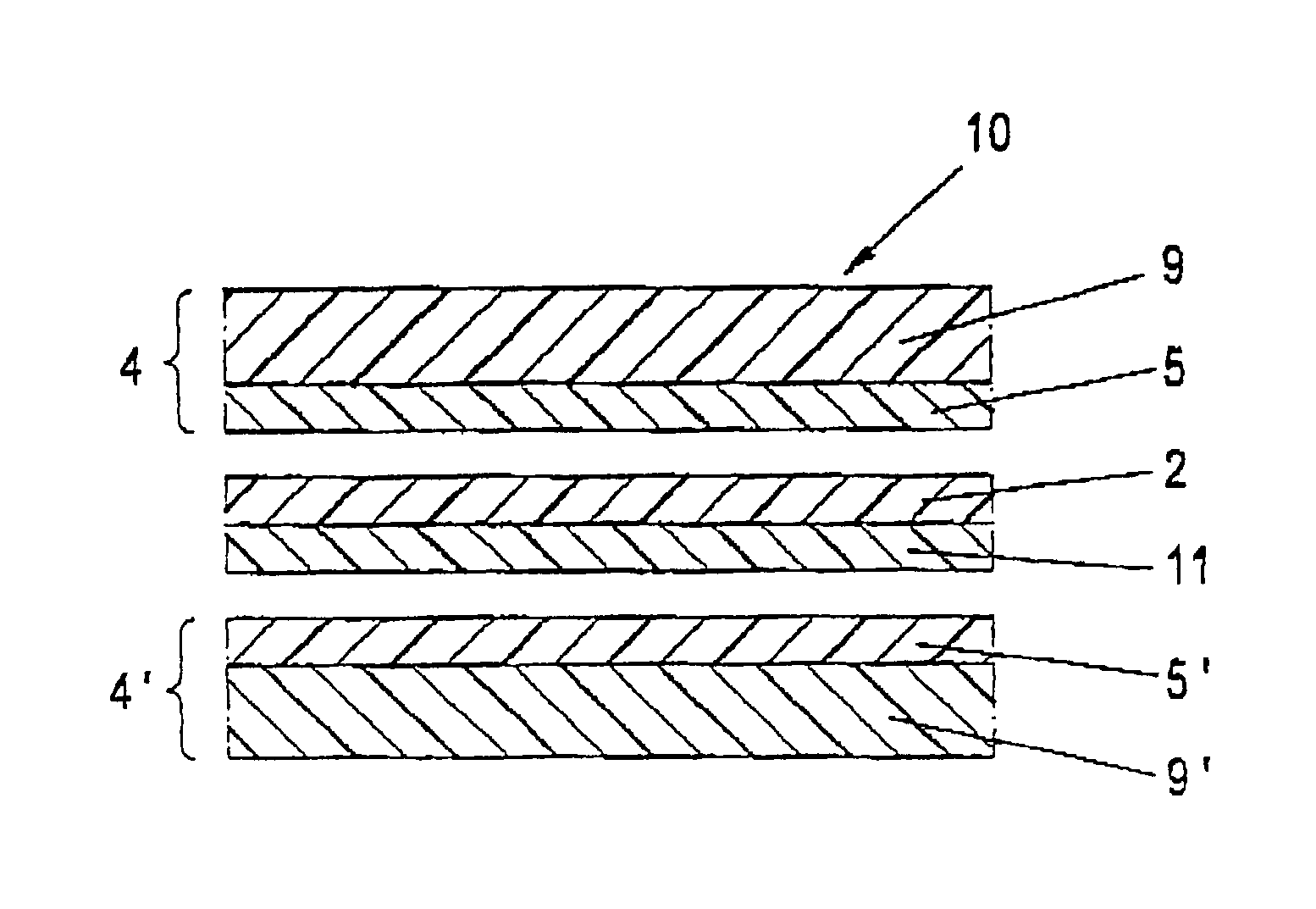Method for producing photovoltaic thin film module
a technology of photovoltaic thin film and photovoltaic cells, which is applied in the direction of pv power plants, synthetic resin layered products, chemistry apparatuses and processes, etc., can solve the problems of relatively high energy consumption of the process itself and long process tim
- Summary
- Abstract
- Description
- Claims
- Application Information
AI Technical Summary
Benefits of technology
Problems solved by technology
Method used
Image
Examples
example a
[0019] Example a):
[0020] Weather protection layer 8: Polyvinyl chloride (PVF) or polyvinylidene chloride (PVDF) in film form,
[0021] Cement layer (not shown): Polyurethane
[0022] Inorganic oxide layer 7: Silicon oxide (SiOx) or aluminum oxide (Al.sub.2O.sub.3)
[0023] Carrier layer 6 for the inorganic oxide layer 7: Polyethylene naphthenate (PEN) or polyethylene terephthalate (PETP) and coextrudates therefrom in the form of films or film composites
[0024] Plastic sealing layer 5: ethylene vinyl acetate (EVA) or ionomers, polymethylmethacrylate (PMMA), polyurethane, polyester or Hot Melt
example b
[0025] Example b):
[0026] Weather protection layer 8: Top Coat coating of polyurethane or polymethylmethacrylate (PMMA) and stabilized polyethylene terephthalate film (PETP film)
[0027] Cement layer (not shown): Polyurethane
[0028] Inorganic oxide layer 7: Silicon oxide (SiOx) or aluminum oxide (Al.sub.2O.sub.3)
[0029] Carrier layer 6 for the inorganic oxide layer 7: Polyethylene naphthenate (PEN) or polyethylene terephthalate (PETP) and coextrudates therefrom in the form of films or film composites
[0030] Plastic sealing layer 5: ethylene vinyl acetate (EVA) or ionomers, polymethylmethacrylate (PMMA), polyurethane, polyester or Hot Melt
example c
[0031] Example c):
[0032] Weather protection layer 8: Fluoropolymers such as ethylene-tetrafluorethyelene copolymer (ETFE), polyvinylidene fluoride (PVDF), polyvinylidene fluoride (PVF) or other fluoropolymer film
[0033] Inorganic oxide layer 7: Silicon oxide (SiOx) or aluminum oxide (Al.sub.2O.sub.3)
[0034] Plastic sealing layer 5: ethylene vinyl acetate (EVA) or ionomers, polymethylmethacrylate (PMMA), polyurethane, polyester or Hot Melt
[0035] In examples a) to c) the components of the encapsulation material 4 are listed; by their interaction they protect the thin film solar cell system 2 against the effects of weathering and the penetration of water vapor.
[0036] Especially fluoropolymers which protect the thin film solar cell system 2 against the effects of weathering, for example UV rays, are chosen as the weathering protective layer 8.
[0037] The inorganic oxide layer 7 in a thickness from 30 to 200 nm is applied by vapor deposition in a vacuum to the carrier layer 6 which consists...
PUM
| Property | Measurement | Unit |
|---|---|---|
| thickness | aaaaa | aaaaa |
| temperatures | aaaaa | aaaaa |
| temperature | aaaaa | aaaaa |
Abstract
Description
Claims
Application Information
 Login to View More
Login to View More - R&D
- Intellectual Property
- Life Sciences
- Materials
- Tech Scout
- Unparalleled Data Quality
- Higher Quality Content
- 60% Fewer Hallucinations
Browse by: Latest US Patents, China's latest patents, Technical Efficacy Thesaurus, Application Domain, Technology Topic, Popular Technical Reports.
© 2025 PatSnap. All rights reserved.Legal|Privacy policy|Modern Slavery Act Transparency Statement|Sitemap|About US| Contact US: help@patsnap.com



